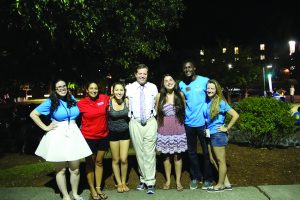Tables of Brandeis’ religious, political and spiritual groups lined half way around Massell Pond on Friday, Sept. 26, starting around 9:15 p.m. This new event, In One Place, was designed to celebrate Brandeis’ far-reaching multiculturalism and will become a year-opening tradition.
The event is based on the Jewish custom of Shabbat “oneg,” a gathering that follows services and often includes dessert, according to a campus-wide email from Dean of Students Jamele Adams. In One Place, however, is non-denominational and includes no religious ceremony. More than 100 students from many faiths and campus organizations attended Friday’s gathering.
“This event was proposed as a way to embrace our historical connection to the Jewish Community and our tradition since our founding of celebrating our pluralistic/multi-faith community,” said Adams. “At the same time, it allows our new and returning students to learn about one another’s faiths and cultures and connect with the many ways we have on campus to support students in these practices.”
 Among the clubs and organizations represented at the event were the Muslim Student Association, the Brandeis Reform Chavurah, Common Ground, the Brandeis University Conservative Organization, the Catholic Student Organization, the Brandeis Orthodox Organization, the Asian Baptist Student Koinonia, Hillel at Brandeis, Chabad at Brandeis and the Multifaith Chaplaincy.
Among the clubs and organizations represented at the event were the Muslim Student Association, the Brandeis Reform Chavurah, Common Ground, the Brandeis University Conservative Organization, the Catholic Student Organization, the Brandeis Orthodox Organization, the Asian Baptist Student Koinonia, Hillel at Brandeis, Chabad at Brandeis and the Multifaith Chaplaincy.
Though Brandeis was founded by members of the Jewish community and has a large population that identifies as Jewish, the school is non-sectarian. Thirty-one percent of students identify as “Jewish” while 40 percent identify as either atheist, agnostic or “nothing in particular,” according to a study conducted by the Steinhardt Social Research Institute last May.
The study also addressed political views and race, finding that “51 [percent] of undergraduates identified as white” while “East Asian students make up the largest group of students of color at Brandeis” at a total of 25 percent. Approximately 66 percent of students described their political leanings as liberal to some degree, while political conservatives made up less than 10 percent.
Despite larger representations of certain cultures over others, some students believe Brandeis does a good job of giving exposure to all the cultures at the university. “I think Brandeis is a nice microcosm because of all the international students, because of all the people from different areas. Especially I think religiously, it has a nice diversity of both events and people who I think reflect the ideas that you’d hope for,” said Faraz Shamsi ’18, a member of the Muslim Student Association.
Hatice Guc ’17, also from the Muslim Student Association, said the large Jewish population puts an emphasis on religion. “[Religion] is naturally given importance in general, hence other religions, even if they are a minority on campus, the light is shed on them as well,” said Guc.
As well as celebrating the diversity of cultures at Brandeis, and the individuality of those cultures, “we must continue to strive to increase understanding, and include not only celebrations, but also space for difficult conversations that increase understanding,” said Adams.
Other students agree there is need for further understanding. “I feel at times there is bigotry from students towards different groups,” said Alexander Mitchell ’17 from the Catholic Students Organization, “There’s anti-Semitism on campus, there’s Islamophobia, there’s a lot of anti-Christian rhetoric … I feel very supported by the university, but I do wish students could be a little more caring and respectful of each other’s faith and traditions.”
Reverend Matthew Carriker, the Protestant Chaplain at Brandeis, also stressed the importance of interfaith events which promote communication and of recognizing the diversity of religion at Brandeis.
“There’s that tension between how do we showcase our strong Jewish roots and identity without making it feel like we’re forcing that,” said Carriker. Other interfaith events, like the Martin Luther King Jr. Day of Interfaith Service, coming up on Jan. 18, work to bring the many different religious backgrounds of Brandeis together in mutual appreciation of faith and religion. Carriker is also involved in the Brandeis Interfaith Group, which hosts events to encourage dialogue between the faiths represented at Brandeis.
In One Place was also an opportunity for Brandeis’ religious and political groups to gain exposure and to “advertise,” according to Bumjoon Park ’17 from the Asian Baptist Student Koinonia.
The event marks a new tradition of cultural recognition at Brandeis, but is just one step towards achieving an improved understanding of the range of cultural identities at Brandeis, according to Adams. He also said the naming of the event was meaningful in and of itself. “Being in one place has, to me, the ring of both the sacred and the non-religious sense of how important this Brandeis home is to all of us. This event is as unique and wonderful as our university family,” said Adams.


